“The wild sheep ranks highest among the animal mountaineers of the
Sierra. Possessed of keen sight and scent, and strong limbs, he dwells
secure amid the loftiest summits, leaping unscathed from crag to crag,
up and down the fronts of giddy precipices, crossing foaming torrents
and slopes of frozen snow, exposed to the wildest storms, yet
maintaining a brave, warm life, and developing from generation to
generation in perfect strength and beauty.”
 Alpine landscape from Southfork Pass towards Bolton Brown.
Alpine landscape from Southfork Pass towards Bolton Brown.
Diet
Bighorn sheep harvest from their gardens like the most discerning chefs. They select the tastiest and most nutritious plants and plant parts available that season. During a mid-summer stroll through the alpine, one can find bunches of blossoms of alpine gold (Hulsea algida) and sky pilot (Polemonium eximeum) growing between boulders. Bighorn munch on these beautiful alpine flowers leaving the leaves and roots to eat in the fall.
Separate summer and winter gardens provide multiple harvests for bighorn that migrate to lower elevations for winter. In years with less snowfall, bighorn converge on low elevation winter range in February or March just as the lengthening winter days provide enough warmth and light for new plant growth to begin. In these snow-free areas, buckwheat and grasses provide small bites of nutritious new green growth, while bitterbrush and sagebrush can provide forage before growth begins.
Some bighorn remain high in the alpine through winter’s raging storms. These sheep find windswept ridges the most hospitable environment. Here strong winds sweep down the eastern escarpment scouring snow from ridgetops to expose frozen remnants of vegetation. At this time of year, bighorn can be seen digging into the frozen earth to eat the roots of grasses, the most nutritious plant parts remaining, while prickly phlox can be found on snow free slopes.
 Coville's Phlox (Phlox condensata)
Coville's Phlox (Phlox condensata)
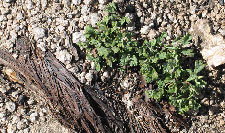 Bitterbrush (Purshia tridentata)
Bitterbrush (Purshia tridentata)
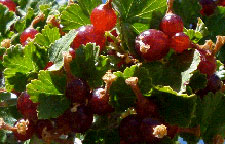 Red Currants (Ribes cereum)
Red Currants (Ribes cereum)
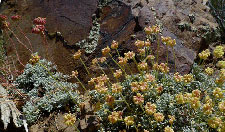 Alpine Buckwheat (Eriogonum sp.)
Alpine Buckwheat (Eriogonum sp.)
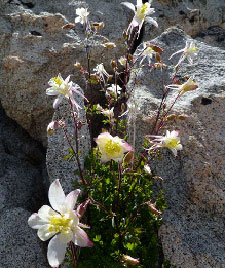 Columbine (Aquilegia pubescens)
Columbine (Aquilegia pubescens)
 Sky pilot (Polemonium eximum)
Sky pilot (Polemonium eximum)
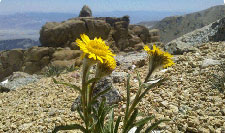 Alpine Gold (Hulsea algida)
Alpine Gold (Hulsea algida)
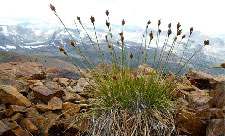 Alpine sedge (Carex kongdonii)
Alpine sedge (Carex kongdonii)
Family Life
“While engaged in the work of exploring high regions where they delight to roam I have been greatly interested in studying their habits. In the months of November and December, and probably during a considerable portion of midwinter, they all flock together, male and female, old and young.
“In spring and summer, the full-grown rams form separate bands of from three to twenty, and are usually found feeding along the edges of glacier meadows, or resting among the castle-like crags of the high summits; and whether quietly feeding, or scaling the wild cliffs, their noble forms and the power and beauty of their movements never fail to strike the beholder with lively admiration.
“In the months of May and June, the wild sheep bring forth their young in solitary and almost inaccessible crags, far above the nesting-rocks of the eagle. I have frequently come upon the beds of the ewes and lambs at an elevation of from 12,000 to 13,000 feet above sea-level. These beds are simply oval-shaped hollows, pawed out among loose, disintegrating rock-chips and sand, upon some sunny spot commanding a good outlook, and partially sheltered from the winds that sweep those lofty peaks almost without intermission. Such is the cradle of the little mountaineer, aloft in the very sky; rocked in storms, curtained in clouds, sleeping in thin, icy air; but, wrapped in his hairy coat, and nourished by a strong, warm mother, defended from the talons of the eagle and the teeth of the sly coyote, the bonny lamb grows apace.”
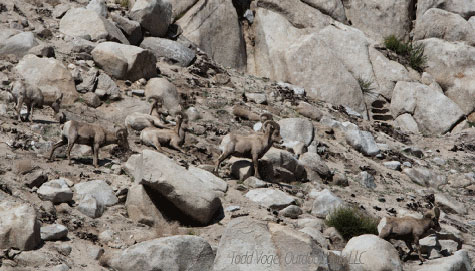 Ram group browsing fresh sprouts in a recent burn (7 Oaks Fire / Mt. Baxter).
Ram group browsing fresh sprouts in a recent burn (7 Oaks Fire / Mt. Baxter).
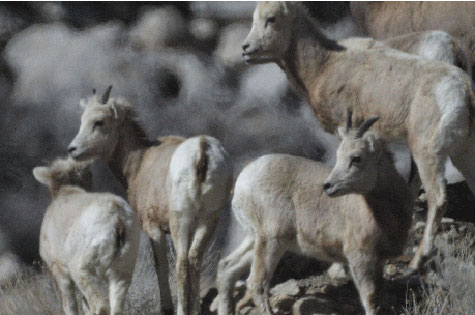 Lamb group on low elevation winter range (note short faces typical of juveniles).
Lamb group on low elevation winter range (note short faces typical of juveniles).
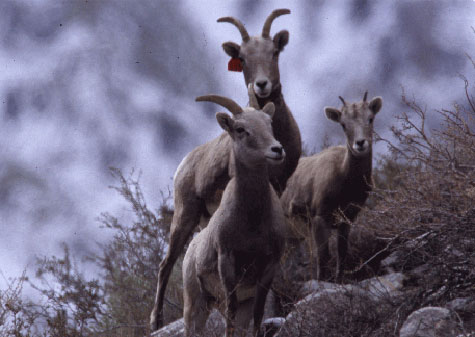 Two adult ewes with lamb at Wheeler crest (red ear tag identifies S17).
Two adult ewes with lamb at Wheeler crest (red ear tag identifies S17).
Survival
“Both ewes and rams made the frightful descent without evincing any extraordinary concern, hugging the rock closely, and controlling the velocity of their half falling, half leaping movements.”
Bighorn sheep are elusive mountaineers, often the only sign of their passing is the sound of rockfall from steep rocky precipices. Travel in this type of terrain requires training for both man and beast. In early summer, when food is abundant and days are long, groups of lambs can be seen honing their skills as mountaineers by playing games of “chicken”. The lambs appear to compete to see who can run farthest up steep, smooth rock slabs before their rubbery hooves loose grip.
Despite being engineered for this environment, random events sometimes get the best of bighorn sheep. Heavy winters produce frequent avalanches, and as the snow recedes rocks fall away from the defrosting cliffs. Sheep that winter in the alpine can suffer heavy losses to their numbers in just one winter. For small populations (most herds in the Sierra have about 30 females, but some have less than 15) two heavy winters in a row could be enough to push them to extinction.
Bighorn in some herds avoid the dangers of alpine winters by migrating to lower elevations. Here bighorn find ample snow-free forage, and by March or April, nutritious new plant growth. However, this luxury often comes with a price. When bighorn winter at low elevation they are often near large deer herds which attract predators like the mountain lion. In one winter a single mountain lion was documented to kill 11 Sierra bighorn. Heavy predation is another way that small herds can slip towards extinction.
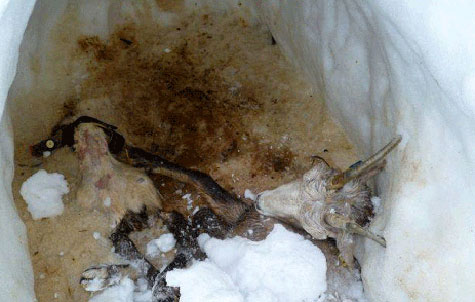 Avalanches sometimes claim bighorn after heavy snows.
Avalanches sometimes claim bighorn after heavy snows.
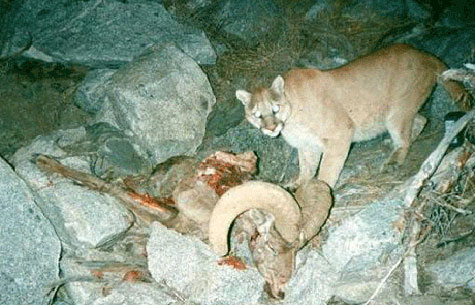 Mountain lions pose another hazard.
Mountain lions pose another hazard.
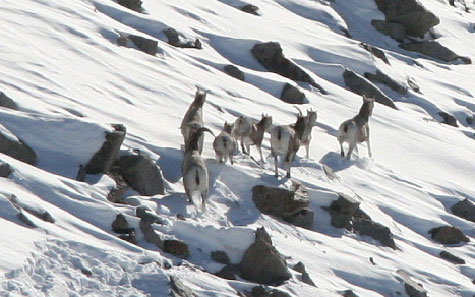 Travel may be difficult after a snow storm.
Travel may be difficult after a snow storm.
Sierra Nevada Bighorn Sheep: View the world from a bighorn sheep's perspective as they move around in a video segment the Counting Sheep documentary, created by Green TV in 2004. Commentary by University of California White Mountain Research Station biologist John Wehausen. (1:49 min) Entire Film
Behavior
Bighorn sheep harvest from their garden like the most discerning chef. They pick the tastiest and most nutritious plants and plant parts available that season. During a mid-summer stroll through the alpine, one can find bunches of blossoms of alpine gold (Hulsea algida) and sky pilot (Polemonium eximeum) growing between boulders. Bighorn munch on these beautiful alpine flowers leaving the leaves and roots for food in the fall.
Separate summer and winter gardens provide multiple harvests for bighorn that migrate to lower elevations for winter. In years with less snowfall, bighorn converge on low elevation winter range in February or March just as the lengthening winter days provide enough warmth and light for new plant growth to begin. In these snow-free areas, buckwheat and grasses provide small bites of nutritious new green growth, while bitterbrush and sagebrush can provide forage before growth begins.
Some bighorn remain high in the alpine throughout winter’s raging storms. These sheep find windswept ridges the most hospitable environment. Here strong winds sweep down the eastern escarpment scouring snow from ridge tops to expose frozen remnants of vegetation. At this time of year, bighorn can be seen digging into the frozen earth to eat the roots of grasses, the most nutritious plant parts remaining, while prickly phlox can be found on snow free slopes.
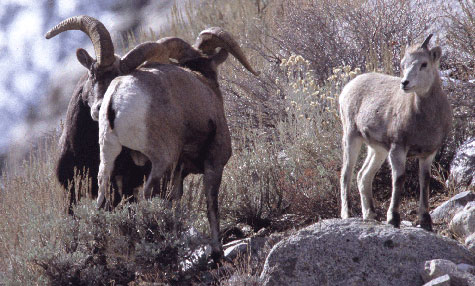 Rams "horn wrestling" part of dominance behavior with lamb watching.
Rams "horn wrestling" part of dominance behavior with lamb watching.
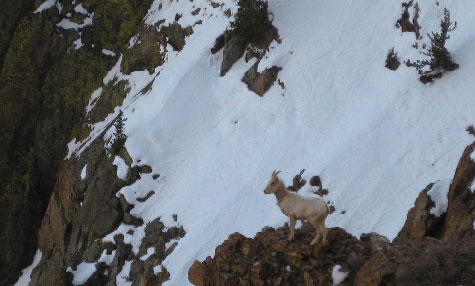 Ewe in late winter visiting lambing terrain.
Ewe in late winter visiting lambing terrain.
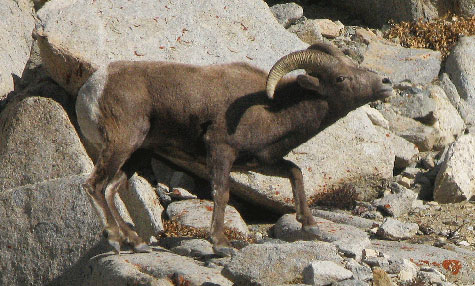 Ram mating behavior (typically October through December).
Ram mating behavior (typically October through December).
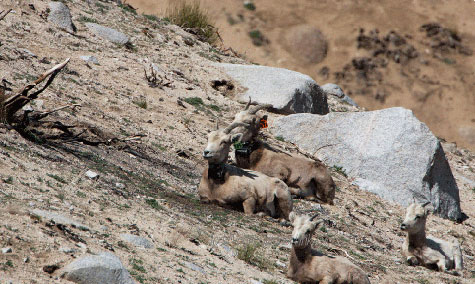 Ewe / lamb group browsing fresh sprouts in a recent burn (7 Oaks Fire / Mt. Baxter).
Ewe / lamb group browsing fresh sprouts in a recent burn (7 Oaks Fire / Mt. Baxter).
Sierra Nevada Bighorn Sheep: View the sheep's intricate mating habits in a segment from the Counting Sheep documentary, created by Green TV in 2004. Commentary by University of California White Mountain Research Station biologist John Wehausen. (2:19 min) Entire Film